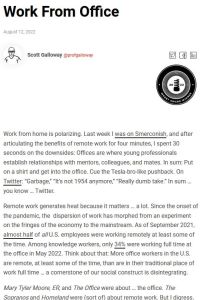Take a client call, feed your cat, update a spreadsheet, bandage your kid’s knee, captain a Zoom meeting, take your aging father to the dentist – remote work can help you meet all the demands of home and of work in the same afternoon. It sounds like a dream, right? But what are you losing out on when you go remote? In this opinion piece, Scott Galloway – a long-time entrepreneur, professor of marketing, author and speaker – shares his thoughts.
The option of working from home is a privilege that is more readily available to high-income earners.
What phenomenon that once resided at the fringes of the economy is now mainstream and dismantling a major component of the modern social construct? Working from home, or, rather, working from “not at your employer’s location” – the idea that an employee doesn’t have to be physically present in the traditional work venue. A full 45% of the US workforce worked remotely at least occasionally in September 2021. And in May 2022, only 34% of American knowledge workers worked full time in an office.
Inequality is burgeoning between those who can and those who can’t work remotely. The majority of workers who can viably work from home tend to be higher-paid information workers, while employees who have to be physically present at their places of employment are inclined to be renters rather than homeowners, to have less education, to lack employer-provided health insurance, and to be people of color. They are the Uber and Amazon drivers, the...
Scott Galloway teaches marketing at the New York University Stern School of Business. He’s an entrepreneur, author, podcast host and public speaker. He wrote The Four: The Hidden DNA of Amazon, Apple, Facebook and Google.









Comment on this summary